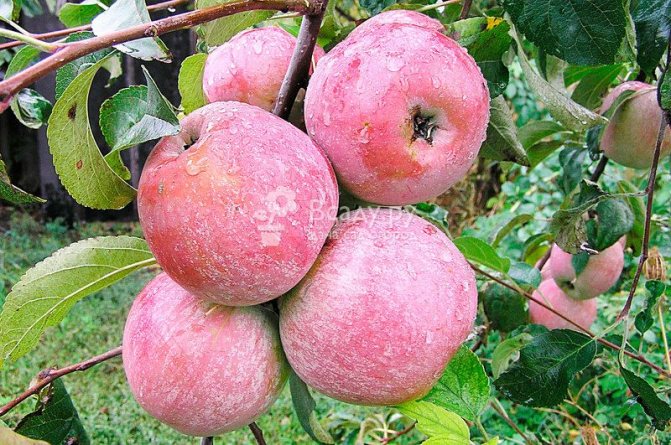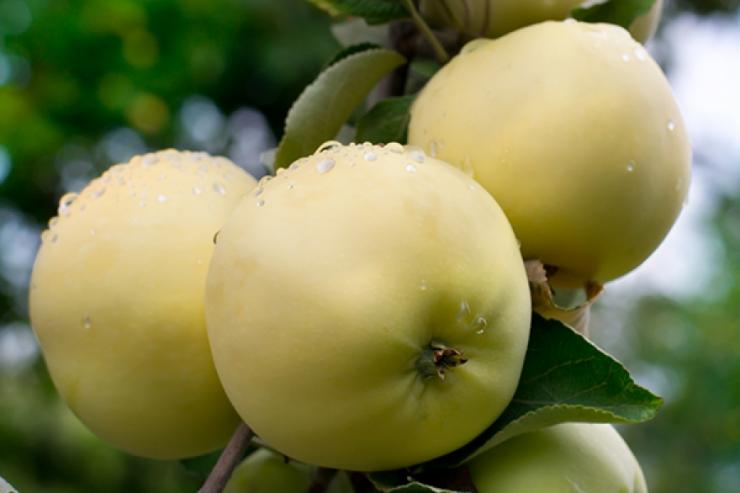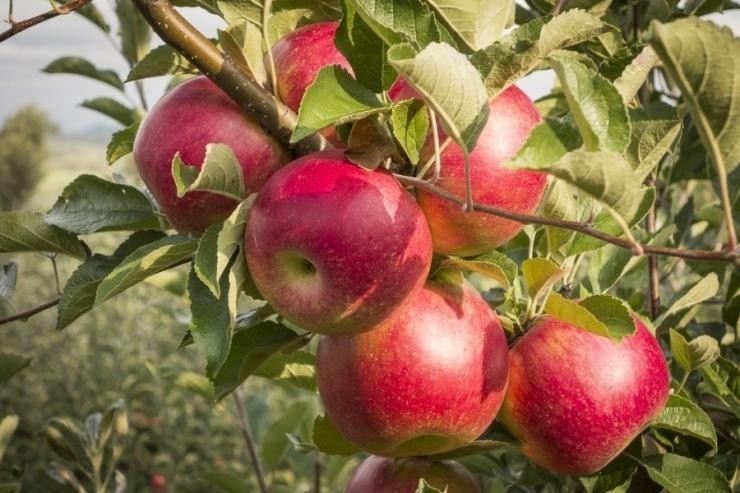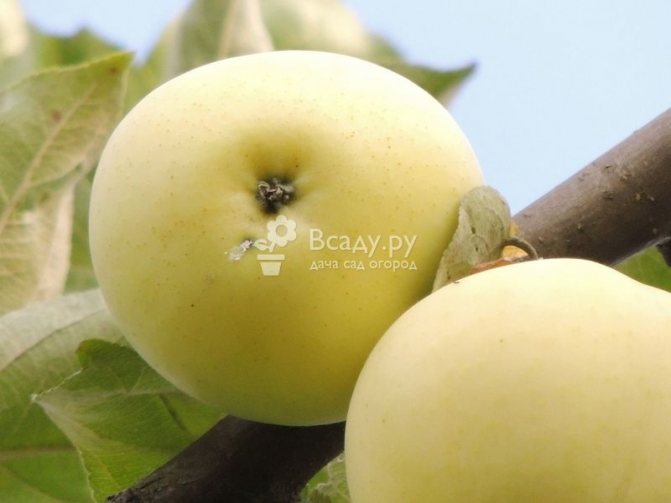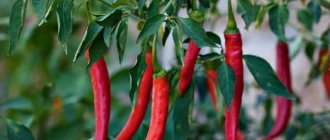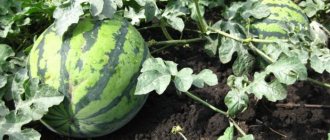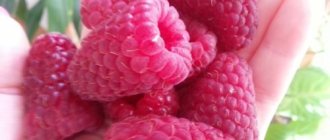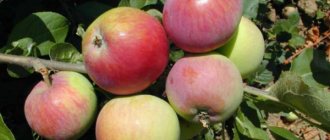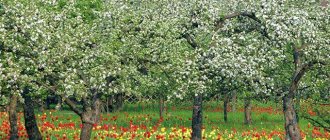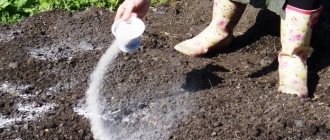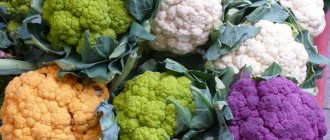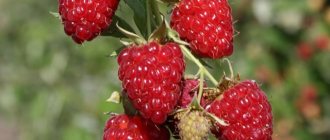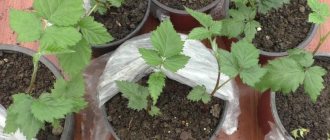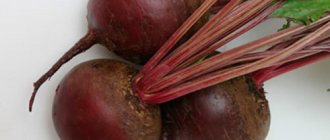»Gardening» Apple tree »Apple trees for Siberia - an overview of varieties
0
6
Article rating
Not every person can withstand Siberian frosts, not to mention plants. Apple trees for central Russia in the northern regions freeze out or die from early flash frosts. Breeders had to develop special varieties for Siberia. They differ in appearance and taste. What they have in common is high winter hardiness and good immunity to scab.
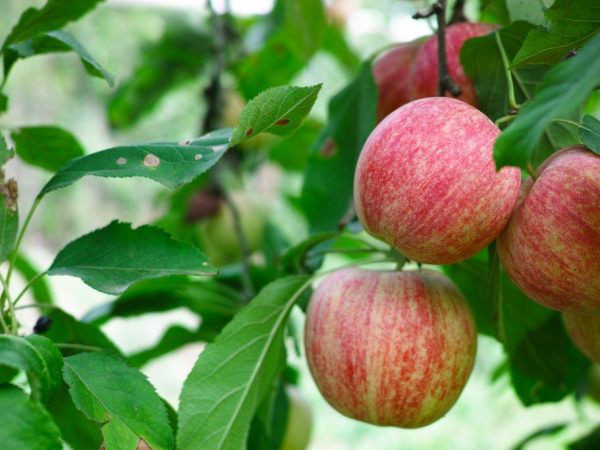
Apple trees for Siberia - an overview of varieties
The best summer varieties
Apple trees appeared in Siberia relatively recently. The first results of successful acclimatization were obtained several decades ago. Summer in northern latitudes is short, most plants with a long growing season simply do not have time to form fruits, but Siberian plants ripen quickly.
New frost-resistant hybrids are able to survive the winter without loss, and both early and late varieties have this feature.
Trees begin to bear fruit already in the last days of July, are edible immediately after harvest, do not store for a long time, and are universal in use.
Ranetka Ermolaeva
Red-sided appetizing apples ripen early, taste sweet and sour, very attractive in appearance. In full ripeness, they are red with a slight pink blush. Small size, low yield. The tree is not tall, the crown is of medium thickening.
The first fruits can be seen by 4-5 years. Shelf life does not exceed 30 days, processed immediately after collection for juice, jam, jam, marshmallow.
Ermakovskoe mountain
The first early apples can be picked in mid-August. They are small, 80-90 g, elegant with a yellow barrel on a red background, light blurred vertical strokes, slightly flattened at the stem.
The tree is of medium height, tolerates sudden frosts well, quickly recovers after prolonged frosts. The shape of the crown is round, the thickening is average.
In a productive year, up to 35 kg of fruits are removed from one apple tree.
Zhebrovskoe
A tall variety, subject to agricultural technology, it grows up to 5 meters. Dark red apples are small, elongated, sit tightly on petioles, form clusters of 3-5 pieces. The semi-crop perfectly tolerates winter frosts, almost no more scab, and is resistant to typical diseases.
Bears fruit regularly, starting at the age of 4. The delicate pulp has a creamy shade, juicy, bright, persistent aroma. Doesn't require pollinators. The harvest is stored for a month, is eaten fresh, classified as dessert.
Melba
The apple tree managed to be zoned for the northern regions, but it still needs additional shelter for the winter. A pillow made of spruce branches or peat on the root segment and a low sacking of the trunk are enough. Unpretentious to care for, tolerates drought well.
The tree stretches up to 3-4 meters, the crown density is small. The average weight of fruits is in the range of 150-160 g, the color is pinkish-yellow, with pronounced stripes, the yield is high, bears fruit annually.
The variety is self-fertile, but on an industrial scale, to increase the number of ovaries, it is planted next to other species of a similar flowering period. It recovers for a long time after the branches freeze.
Minusinskoe red
The variety was bred in 1943, intended for the northern regions. It grows slowly, reaching 2.5-3 m. The crown is spreading, branches are rare.
Fruits are small, one-dimensional, ripen together, starting from August 20, weight from 20 to 35 g.
The color of ripe apples is golden yellow with a blurred brownish blush. The yield is average, but it bears fruit stably, without rest periods.
Russian beauty


The variety will delight you with its yield
Early winter hardy apple tree. The crown is spreading, oval, not thickened. Belongs to large-fruited varieties, the average weight of an apple is 120-150 g. Color in full ripeness is bright red.
Bears fruit abundantly, increasing yields to 21-30 kg, starting at 4 years of age.
The pulp is slightly sour, white on the cut, juicy. The seedlings adapt easily after transplanting, but require additional shelter for the winter.
Planting and leaving
Landing
Timing
The best time to plant apple trees in harsh climates is Spring... Otherwise a young, immature seedling, when planted in autumn, may not withstand severe frosts.
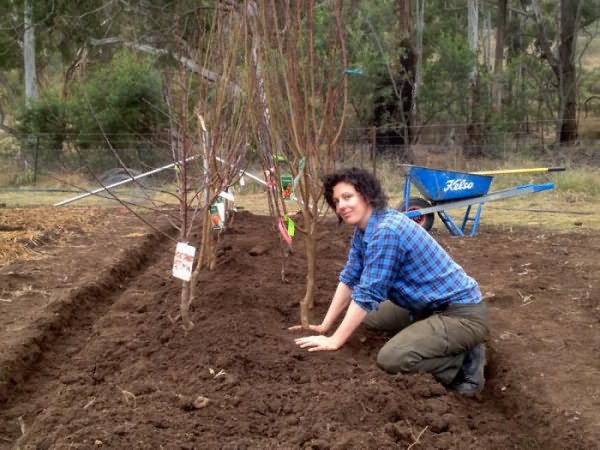

In Siberia, apple trees are planted in the spring.
It is worth noting that planting dates for Western and Eastern Siberia are the same, that is, planting apple trees in autumn in Tomsk, as well as in Krasnoyarsk, is not recommended.
Features of the
If the seedling was purchased in the fall, then it is better to dig it in with well-rotted humus before the onset of spring.
The features of spring planting are almost the same as in other regions of the country. A sunny, better windless place is selected. Closely located groundwater is destructive for this type of fruit. The soil should be non-acidic.
The planting hole is dug in the fall. And in the spring, it is covered with fertile soil with fertilizers and a seedling is planted in it, which is spilled with high quality.
Growing apple trees
Crohn needs pruning and shaping throughout its life. If at a young age she stimulates the plant to branch more or to form fruit shoots, then in adulthood she needs sanitary pruning and rejuvenation measures.
Caring for an apple tree in Siberia also includes fertilizing with fertilizers and mineral complexes. She is compensates the wood for the lack of heat, sun and other components missing in a harsh climate.
Important! Any dressings are applied only on well-shed soil and not at the root, but in the area of the trunk circle in a groove specially prepared for this.
In such conditions practically does not need watering, unless there is dry and hot weather for a long time.
Preparation for the winter season is a must. The trunk circle is covered with humus or peat with a layer of at least 20 cm.
Such a process should take place gradually, increasing the layer with each decrease in temperature, so that the plant calmly goes into "hibernation". In addition, after snow falls, the trunk circle is abundantly covered with it.
Diseases and varieties resistant to them
The apple tree has a lot of diseases and pests. And without preventive measures, it is difficult to avoid any disease.
Modern hybrids are predominantly have such advantages as resistance to the main disease of this culture - scab... But in epiphytotic years, the immunity grafted may not work. Only fungicides can save during such periods.
Milky sheen lesions widespread... The culture does not even have time to bloom. Drops flowers, branches begin to fade and after a while the branches dry up, their tips turn black.
Attention! Only preventive, annual, consistent spraying and proper maintenance will prevent this. Fully resistant hybrids have not yet been bred. Therefore, only prevention will save.
The most stable are:
- Welsey;
- Borovinka;
- Altai Bagryanoe;
- Antonovka;
- Lungwort;
- Altai souvenir.
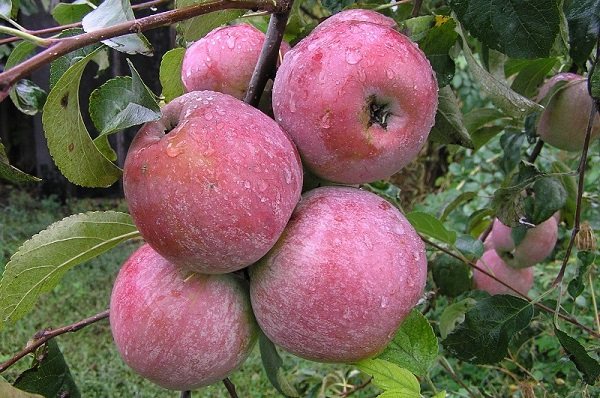

Welsey is one of the most resilient apple trees.
The best autumn varieties
This group includes apple trees that bear fruit from the second half of August to mid-September. Apples are stored longer, tolerate transportation well, and are versatile in use.
Altai crimson
Differs in increased frost resistance and fast regeneration.
The fruits are cone-shaped, can be stored for a long time - they lie in a cool dark place for almost 2 months, without losing their original qualities. The tree is medium-sized, the yield is small, up to 20-21 kg, but the taste is highly appreciated by experts and consumers.
Darling
Bred at Moscow State University. MV Lomonosov, the basis is taken by Befler Kitayka and Antonovka. The growth rate is moderate, the crown is sparse, spreading, the skeletal branches are located almost horizontally. Shoots are thick, short, wind and frost resistant.
Fruits are large, with creamy pulp and a bright aroma, juicy, refer to dessert. They ripen in September, they can lie until November, the application is universal.
Altai souvenir
The variety is very fond of gardeners of Siberia, Krasnoyarsk Territory, Altai. The apple tree is zoned for the northern regions, winter-hardy, unpretentious to conditions.
The yield is stable. Fruiting begins early, from the age of 4.
The apples are bright, not very large (one weighs from 80 to 130 g), saturated red with a slight golden blush and thin vertical stripes. Ripen in early autumn, amicably. Stored up to 2 months in a cool, dark place.
Surkhurai
The variety turned out to be very resistant to freezing, does not suffer from fungal diseases, including scab, grows well and bears fruit regularly in the northern regions.
Apples are medium-sized, up to 85 g, slightly flattened, placed in 4-5 pieces in one outlet. Taste sweet and sour, dessert. The color at the stage of full ripeness is red with golden splashes.
The level of ovary formation is high. The term of fruiting is the last days of August, apples from the branches do not crumble, they last until mid-October. Storage time does not exceed 1 month, transportable.
Bayan
Large-fruited varieties are rare in Siberia. Bayana has become an exception. By its existence, it proved that large apples can be obtained in the northern regions.
The first harvests appear 3-4 years after the planting of the seedling - the apple tree is considered early-growing. At first, it forms few ovaries. The volumes are increasing every year.
For annual fruiting, planned pruning and elimination of thickening is necessary, otherwise, instead of forming ovaries, it will direct its forces to increase the green mass.
Application methods
Hedge
In most cases, it is planted as a single plant in the center of a lawn or lawn. But it is also widely used as a hedge, in a mixed border, which creates a decorative look in both spring and autumn. And the property is good to tolerate pruning, allows you to create any shape from wood.
Decorative properties of wood
Apple wood has found wide application in the manufacture of various handicrafts, turned products.
It is widely used by artisans for the manufacture of carved products. They are used in mechanical engineering for interior decoration and in the furniture industry.
The structure of wood is notable for its density, strength, excellently lends itself to cutting, polishing. Suitable for turning, joinery and small crafts.
Application in medicine
For medicinal purposes use apple honey, which bees prepare if the hives are located nearby.
Apple cider vinegar made from Berry apple trees has medicinal properties that aid digestion.
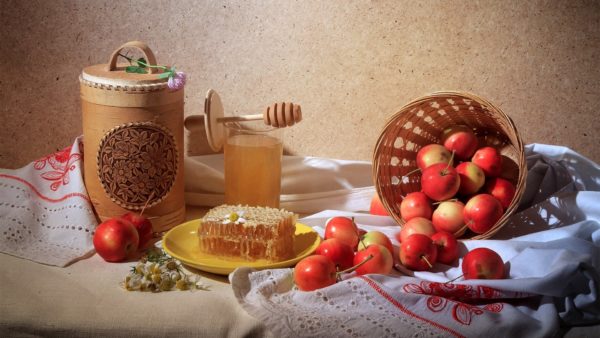

The berry apple tree is a wonderful honey plant.
In folk medicine, not only fruits are used, but also leaves and flowers, of which, after drying prepare medicinal infusions.
The best winter varieties
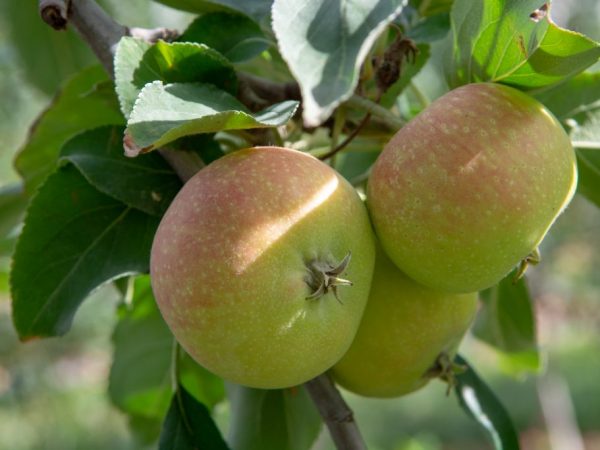

The fruits can be kept fresh for a long time.
There are few varieties and they almost do not differ from the autumn ones: the difference in the timing of apple picking is 2-3 weeks. In October, frosts often begin, by this time you need to have time to harvest.
Another difference is that it is the fruits of winter varieties that can be stored for a long time without losing their taste.
North synap
One of the most frost-resistant and fruitful varieties. Requires regular feeding and pruning. A creeping form has been bred for Siberia.
The tree is large, tall, the crown is pyramidal, with numerous lateral branches. Fruits grow up to 120 grams, the main color is yellow-green with a red barrel. They ripen in October, do not crumble.
You can only remove completely ripe apples, otherwise they will not be stored for a long time, and the taste will not open up to the end. They remain fresh until early May.
Ainur
One of the recently withdrawn. Outwardly, it is very similar to Golden Delicious, the same shape of large fruits, the color is green-golden with a mass of internal dots, the weight ranges from 180-200 grams. The apple tree is distinguished by early fruiting, the first harvest is removed 3 years after planting.
Fruits are stored until March, the full range of flavors is revealed one month after harvest. It is not recommended to eat apples immediately, they are still harsh. But then the pulp becomes juicy, aromatic, with a slight persistent aroma of sweetness and freshness.
Legend
Early winter frost-resistant variety. It has a dwarf and columnar shape. Obtained by crossing Fuji and Lingonberry. I took over from my parents a high resistance to frost and other unfavorable natural conditions. Differs in a compact crown, increased regeneration, early onset of fruiting.
The fruits are large, up to 180 g, the color is greenish-raspberry, the peel is dense, the taste is estimated at 4.5 points by the tasting school.
Lyubava
The hybrid was introduced at the Krasnoyarsk breeding station with the participation of N.N. Tikhonov and P.A. Zhavoronkova. The emphasis was on winter hardiness, regularity of fruiting, and scab resistance.
The tree is tall, resistant to winds and prolonged frost. Bears fruit annually. Fruit weight within 100 g, white pulp, with small grains, juicy.
The yield per tree reaches 45 kg. Hand-picked fruits are placed in wooden or plastic boxes and stored for up to six months.
Pear
Less hardy than an apple tree, it suffers more from sunburn.
In harsh regions, Altai varieties are difficult to succeed (the most interesting is Perun - Recommended for low, cupped shapes.
Medium-fruited Ural varieties grow well:
- Krasulya,
- Uralochka,
- Taiga,
- Century,
- old Krasnoyarsk (New, Thumbelina),
- old Far Eastern (Topic - technical grade).
For a pear, they choose a warmer place than for an apple tree, and they protect it more for the winter. Central European varieties are grown in a creeping form (Chizhovskaya, Lada).
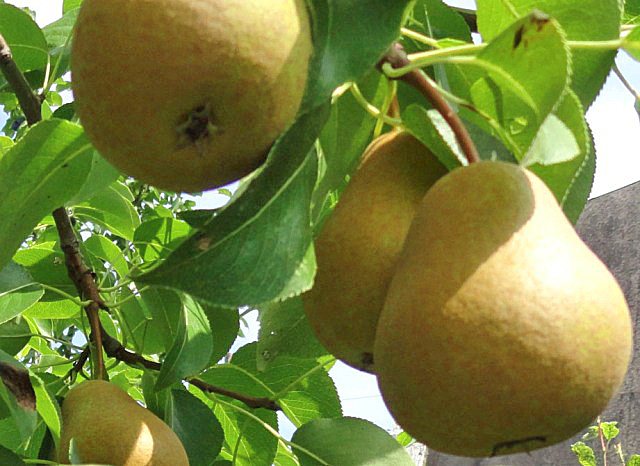

Photo: Thumbelina
Varieties for Eastern Siberia
Most of the territories are located on hills, the subsoil waters are deep, but strong winds are constantly blowing. In such conditions, tall plants find it difficult to withstand the harsh winter.
For these areas, species that are more resistant to climatic whims with increased frost resistance and a high ability to regenerate after superficial frostbite have been bred.
These varieties include:
- Lydia - self-pollinating, fruiting in the last week of August with bright red elegant apples;
- Autumn joy - initially adapted for harsh conditions with prolonged frosts, apples are golden-green with many blurry thin stripes, dessert, weight up to 150 grams, are not affected by scab;
- The pupil is self-fertile, early, fruitful, sweet apples, medium-sized, effective in appearance, have excellent taste characteristics;
- Young naturalist - considered an old, well-proven variety, bred in the first half of the 20th century, one of the first intended specifically for northern latitudes, cultivated on an industrial scale, transportable.
What to protect fruit trees from?
In recent years, we have seen more and more extreme weather conditions:
- sudden changes in temperature in summer, including daily (cold nights and heat during the day),
- long dry winds in spring,
- heat atypical for the season (April - May),
- drought or wet cloudy weather with unproductive rainfall, which leads to the massive development of diseases.
Prolonged downpours (like drought) lead to root death.
For fruit and berry crops, such winter damage as
- sunburn and frost in February - March,
- severe frosts with insignificant snow cover in November - early December, as well as in February,
- withering winter winds.
For snowy regions, tissue damping out under deep wet snow is dangerous.
They resist the dangers of the climate well (winter-hardy, perfectly recover and bear fruit annually), not all varieties have high-quality berries.
Varieties for Western Siberia


Winter-hardy varieties are suitable for Siberia
The areas are swampy, which, in combination with low temperatures, increases the risk to the root system of plants. The climate is continental, the winter period lasts from 7 to 9 months. Saves a large amount of snow, covering the vegetation with a warm cover.
The main requirements for apple trees are early maturity, winter hardiness, superficial root system.
- Altai beauty is grown in normal and slate form, creeping species have a better chance of surviving in harsh conditions. The apples are medium-sized, round, red with a distinct white background. The pulp is dense, pinkish, juicy, with a dessert taste. Fruits ripen in summer and cannot be stored.
- Altai Amber is distinguished by a delicate white-golden color of fruits. The semi-culture is self-fertile, demonstrates high frost resistance and scab resistance. Apples are sweet, medium-sized, with creamy juicy pulp.
- The cherished pleases with piercing scarlet fruits, which look very impressive against the background of foliage. The variety is valued for its frost resistance, quick regeneration, and excellent immunity. The pulp is sweet with a subtle hint of strawberries.
Cherry
Steppe and hybrid cherries (1–2 m high) are relatively successful in harsh regions.
In winter, cherries are often
- freeze slightly above the snow level (especially tall Ural varieties and most Altai varieties),
- suffer from sunburn of the bark and damping off (undersized forms and varieties of Omsk selection).
Coccomycosis is widespread, and the cherry fly has been rampant in recent years.
For planting, choose a sunny place corresponding to the variety:
- for undersized forms - little snow,
- for tall people - snowy, warm, little wind.
Of the trimming elements, the clarification of the crown is of decisive importance (they cut out excess, thin from the inside and old shoots), do not shorten the one-year growth, where the main crop is concentrated. If the variety suffers annually in winter and gives a lot of extra growth, change the formation or remove the bush.
In the harsh regions of Siberia, only undersized varieties bear fruit stably:
- Kasmalinka,
- Altai early and local forms,
- in Altai - all Altai varieties.
In the Ural region, European and local varieties do well:
- Ashinskaya,
- Lyubskaya,
- Seedling Lyubskoy.
Everywhere in the stanza-bush form, you can grow European varieties that are more resistant to damping:
- Chocolate girl.
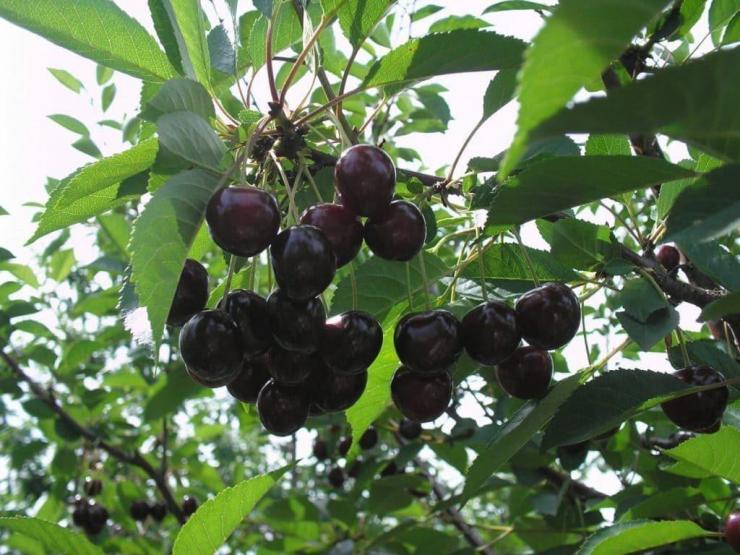

Photo: Shokoladnitsa
Columnar
These varieties have a number of advantages:
- compact in size;
- fruiting begins earlier;
- branches break less under heavy winds;
- ease of harvesting and care.
The president
Columnar semi-dwarf variety.Fruits are formed in 3 years, give up to 15 kg of large sweet apples with a slight sourness. Storage up to 1.5-2 months, suitable for consumption immediately after harvest, as well as for drying, processing into juice and jam.
Currency
The maximum height in an ingrown state is 2.2 m. Apples ripen in the first week of October, the volume reaches 10 kg, when the ripeness stage is reached, apples do not crumble. They are stored for a long time, do not lose their presentation when transported over long distances. The taste is sweet, the acid content is negligible.
Nectar
Appreciated for the elegant color and great taste of apples. The color in full ripeness is rich golden, the flesh is sweet, white with a taste of honey, juicy. The fruits are large, individual specimens reach a mass of 250 grams. The first crop is harvested 2 years after planting. The application is universal.
What is this type of tree
- the advantages of the tree can be safely called small size and excellent external data. The apple tree will decorate any area, adding colors and a certain atmosphere. It belongs to ornamental plants, begins to bear fruit as early as the 3rd year;
- the plant does not differ in special taste. They are bitter-sour and slightly woody in taste. It is often used as a decoration. But, however, gardeners claim that the jam made from them has a pleasant taste. Used for the preparation of dry jelly, wine, juices, syrups and jellies, marmalade, etc. Apples give a special taste to the cooked product;
- the yield every year is excellent, the tree is strewn with small fruits ranging from red to orange. Drought-resistant plant. It belongs to the most winter-hardy species among apple trees. Since it can withstand frosts down to -56 ⁰С. Protected in protected areas;
- with proper tree care, you can forget about diseases and attacks of pests and not worry. The berry apple tree is slightly less susceptible to other plants. If the slightest signs of disease or pests are found, action must be taken. This is necessary to prevent damage to all existing trees on the site;
Main problems:
- Bacterial burn.
- Powdery mildew.
- Scab.
- Green aphid.
- Hawthorn caterpillars.
In order for the effect of chemical treatment to be stronger, all damaged leaves, branches and fruits must be removed from the tree.
The life span of a tree is different, it depends on the growing conditions, care and damage by pests and diseases. She begins to bear fruit from the age of 5.
The distribution of the berry apple tree is very wide, especially considering that there are several varieties of this tree. It is extended to:
- the Far East;
- Siberia;
- China;
- India;
- Nepal, etc .;
In the wild, it grows along the banks of rivers, along the slopes of ravines, in deciduous forests.
Lyudmila claims that the plant is very beautiful not only in spring, but also in autumn, and she does not cook jam from it, since no one likes it. But the compote made for the winter did not leave indifferent any household. Because of its excellent taste, tart and slightly sour.
Alexander says that he uses a similar variety of apple trees to decorate the site. Apples do not remove, as the tree looks beautiful in autumn, without foliage. It is just strewn with bright fruits. Does not leave indifferent any guest who has visited his house.
Natalia, an experienced gardener, says she makes good use of the apple tree as a hedge. Since she easily tolerates pruning and amazes passers-by with gentle beauty in the springtime. When the plant turns into one continuous flowering ball.
We suggest you familiarize yourself with: How to keep potatoes on the balcony in winter
The apple tree propagates in all known ways:
- cuttings;
- seeds;
- seedlings;
- overgrowth from the stump.
The easiest way to do this is with seedlings. This is the most effective method. It is important to consider some requirements for the preparation of the site and land.
The landing pit must be prepared in advance.1-2 weeks before planting. The soil should be saturated with oxygen, this will make it easier for the plant to transfer the transplant.
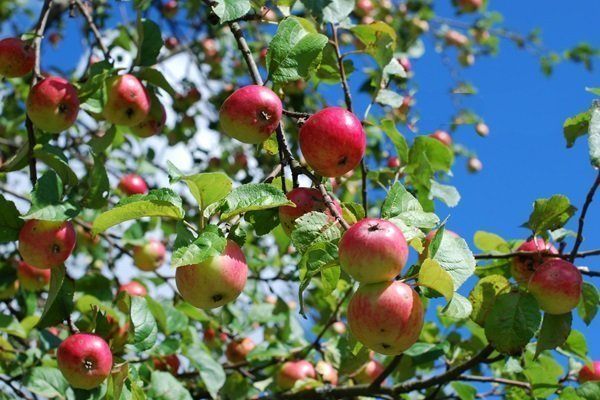

It is best to plant a tree in spring, even before the juice starts to move, or in autumn, given that the plant needs time to take root.
Soil requirements
It should be neutral or slightly acidic. It is recommended to lime strongly acidic soil by treating the roots with lime.
When choosing a planting site, do not overlook the fact that the tree loves the sun. Therefore, it is planted in sunny areas. If the tree does not receive the required amount of sunlight, the risk of fungal diseases increases. The distance between seedlings is at least 5 meters. Groundwater should run at least 1.5 meters underground.
The fertility of the soil may not be the highest, the apple tree will still grow and yield a harvest, since it is unpretentious. The seedling hole should, on average, be 50 cm wide and 70 cm deep.
A soil mixture is prepared in advance for filling the seedling. It includes:
- 3 parts of humus;
- 2 pieces of sand;
- 1 part of the fertile layer of the earth.
If desired, you can add mineral fertilizers and peat.
A seedling is lowered into the prepared hole, so that the root collar rises 5 cm above the ground. The roots must be straightened, then covered with the prepared mixture. Drizzle with plenty of water. After that, you can loosen the earth so that the moisture remains in the soil longer.
Time for planting in spring is March and early April. In autumn, it is September and October, it is important to give the tree the opportunity to start before the onset of cold weather and the first frost.
Apple trees, which are more than five years old, can hardly tolerate a transplant; for the first few years, their growth slows down significantly.
If it is decided to reproduce with the help of seeds, it is not difficult to do this. In the fall, the seeds are sown in the ground and stay there for one year. Then, after the seedling gets stronger, it is transferred to a permanent place.
Dwarf
It is impossible to grow them in their original form in the conditions of Siberian frosts. Only crossed, semi-dwarf and other semi-crops survive. The most popular are:
- Altai ruddy, the advantages of which are called early maturity, the versatility of the use of the crop, is used as a basis for further selection;
- Palmetta gives the first apples for 2 years, the harvest is annual, 4-6 kg each, small fruits have a great taste and bright scarlet-raspberry color;
- The non-female is resistant to fungal and bacterial diseases, bears fruit regularly, the average weight of apples is from 50 to 100 g, shows good frost resistance, is suitable only as a dessert, since the pulp is loose and is not suitable for blanks.
Testimonials
Nina. “A wonderful apple tree with childhood memories. The boys happily ate apples that were exposed to frost. It is still growing, without any care and has never been sick. "
Peter. “We have about 20 trees densely planted along the road. Spring is just a miracle to be seen. The whole road is white on both sides. And how many birds in the trees in late autumn ... "
Sofia. “We have been growing Siberian berry for more than a dozen years. We formed three trees under a beautiful ball and set a table under them. This is our favorite summer spot. There are always birds on the tree, there is shade under it on a hot day and there is no wind. And in the spring ... beyond words! "
Stamp
For such apple trees, the most relevant form of pruning is a ball.
In the process of forming the crown, the lower branches are removed, and the rest of the green mass is given the appearance of various geometric shapes, so caring for them does not require much effort.
The following varieties are most often grown:
- Miass, which is appreciated for delicious apples with a pronounced acidity and high immunity, the species is used for further breeding work;
- High yields up to 50 kg. from 1 tree.The fruits are small, with a red blush, tasty, stored for 45 days;
- Tavatui belongs to novelties, there are few responses, but mainly its yield, good taste characteristics, and winter hardiness are noted.
Low winter resistant
Each of these groups has its own frost resistance limit, and if it is exceeded, then one can no longer hope for a bountiful harvest of apples.
In the case of low-winter-hardy plants, such a threshold is considered to be below -27 ° C, which means that the well-known Spartan and Lobo varieties should be planted only in the southern regions of Siberia or in the central part of Russia.
Spartan
This is a variety of late ripening terms, with high yields (up to 100 kg of apples from 1 medium tree) and excellent taste of the fruit. Harvesting begins no earlier than October, but for the apples to taste better, they must lie down until December.
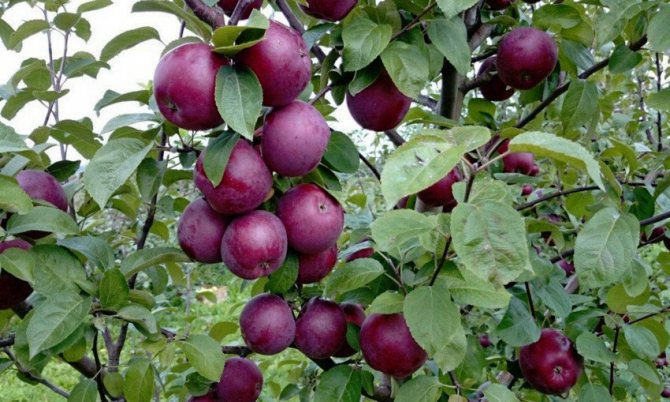

Spartan trees are represented by medium-sized plants (up to 5 m in height) with a rounded crown. Lateral branches are completely absent, and annual shoots are covered with pronounced pubescence of a dark brown or cherry color.
Dark green leaf plates are round, medium in size, with a median base and a twisted end. The flowers have standard sizes and are white-pink in color, collected in compact inflorescences. In the future, light yellow, rounded, with a slight blush, fruits, weighing 150-200 g each, are formed on the shoots.
Their main feature is the presence of a bluish bloom on the surface of the apple, which makes the fruit appear dark blue or even purple. The pulp is white, very juicy and crunchy, with small red streaks. The taste of apples is predominantly sweet, but a slight sourness is still felt.
The sweetest varieties
The chilly summer prevents apples from accumulating the desired level of sweetness. The breeders set out to create several varieties that can accumulate a maximum of sugar substances in a short time.
Good options include:
- Grushovka Moskovskaya is known for its excellent taste characteristics, apples are small, elegant, sweet, but completely non-transportable, not suitable for storage;
- Melba, with timely processing from scab, gives fruits with a sweet-candy taste, fruitful, frost-hardy;
- The cherished pleases with a sweet taste with a barely noticeable acidity and the aroma of ripe strawberries.
The dream of growing apple trees in the harsh conditions of northern latitudes has come true thanks to the hard work of breeders. Choosing varieties of apple trees for Siberia, you do not have to worry about the fact that a young tree will die from frost.
It is important to take care of the trees in the first year, additionally insulating the trunk circle. And further special care is not required, it remains only to follow the general recommendations for watering, feeding and preventive treatment against pests.
general characteristics
Currently the variety of species is amazing... The most important event is considered to be the correct choice and adherence to all growing rules.
Only then are these fruit trees capable of producing a decent harvest in prolonged cold climates.
For both Western and Eastern Siberia, this the fruit crop must have certain characteristics and requirements.
Such as:
- Winter hardiness - resistance to prolonged frost. There are species with medium and increased winter hardiness, capable of withstanding frosts above 40 ° C. Not requiring a lot of sun and moisture;
- Productivity and early maturity... Nobody wants to grow low-fruiting apples or wait 5-6 years for the first fruits to appear;
- Ripening terms. For such a cold climate, ripening should end before the first frost;
- Plant resistance to all kinds of diseases... The main ones are scab, rot and fungal diseases of the apple tree.All kinds of pests who want to feast on leaves, bark and fruits of a tree cannot be ruled out;
- Taste characteristics... Any gardener dreams of sweet or slightly sour fruit. Everyone wants juicy and aromatic apples;
- Harvest storage... The later the ripening period, the longer the storage.
Important! When planting a new variety, know all its characteristics and the recommendations of experienced gardeners on the conditions for its cultivation. This is the only way to decide which varieties of apple trees are best for your garden.


